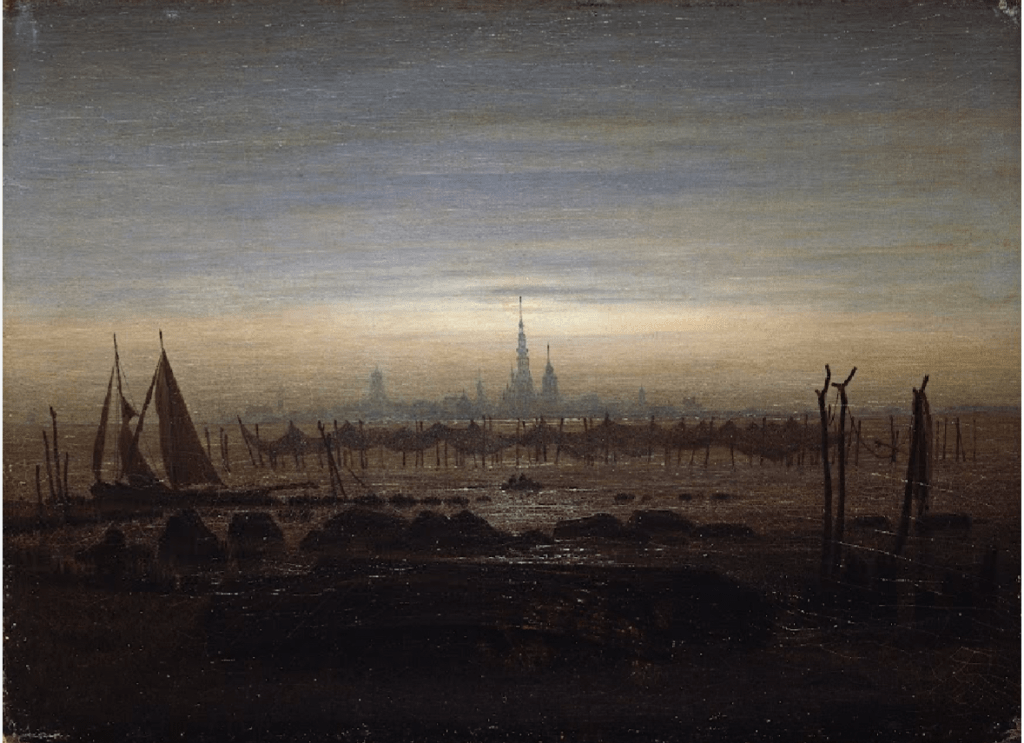
Contributed by Margaret McCann / “The Soul of Nature”at the Metropolitan Museum of Art is one of many exhibitions dedicated to German Romantic painter Caspar David Friedrich (1774–1840) on the 250th anniversary of his birth. Some of his finest are absent – the epic Sea of Ice‘s vision of an arctic shipwreck, The Great Enclosure‘s resonant view of a Dresden field Napoleon amassed his troops on, or Ruine Eldena, one of Friedrich’s many depictions of the remnants of the powerful Catholic monastery his hometown Griefswald formed around. But there are numerous studies displaying his keen observation of nature, research he used for paintings creatively orchestrated in the studio. Throughout the show, Friedrich’s potent visual memory and brilliant recreation of light phenomena shine. His paintings of the “Good Book of nature” mediate “the artist’s feeling is law” and fierce Lutheran Pietism, sometimes resulting in the “cold and weird”. In Greifswald in Moonlight, melancholy and conviction are in equilibrium. Within an enshrouding darkness a deep, gloomy space is gently defined. Sensitive illumination reveals precise reflections guiding us across the water’s surface.
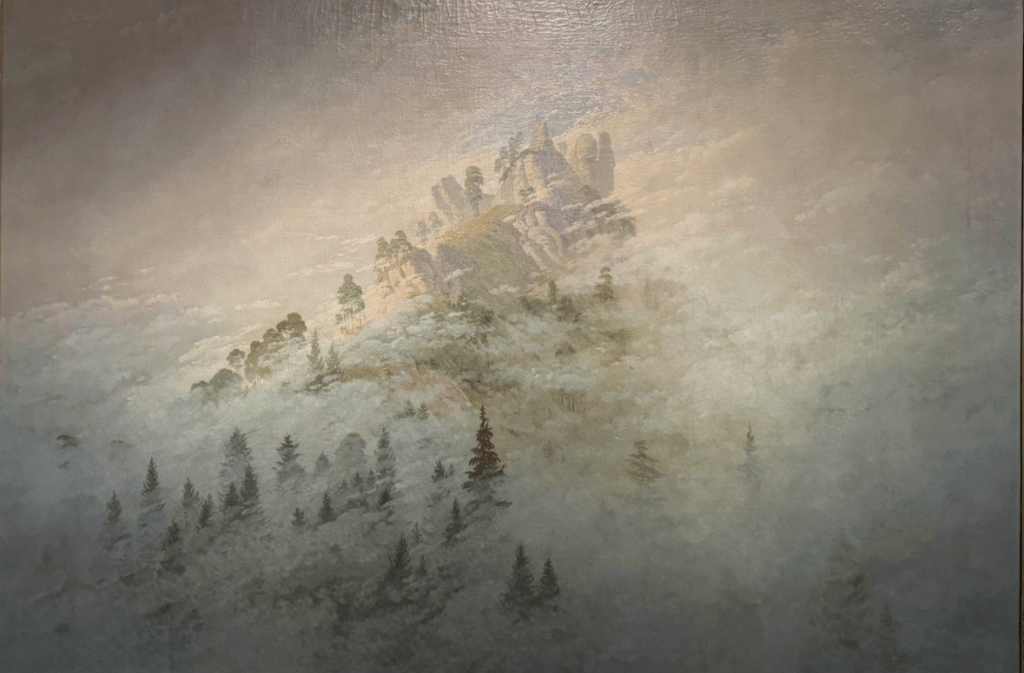
Awesome wonder is in tension with loneliness and desolation in Morning Mist in the Mountains. A moody vignette effect, like that in Greifswald in Moonlight, implicates the Claude glass, an optical device popularized in the 18th c. that gave any dull scene a melodramatic patina. Cloaked in severe weather, the mountain is grand yet doleful, obscurity and vastness evoking Edmund Burke‘s 1757 characterization of the sublime. Friedrich’s Romanticism drew from his avid hiking, religious conviction, and introspection shaped partly by privation. As a child he lost his mother, and a brother who died saving him from drowning. Friedrich had a family – and friends, some of whose works are in the show – but was a loner: “You call me a misanthrope because I avoid society… I love society. Yet in order not to hate people, I must avoid their company.” Subtle tones convey hope obliquely. A small cross at the distant pinnacle suggests Golgotha, our visual ascent echoing a pilgrimage.
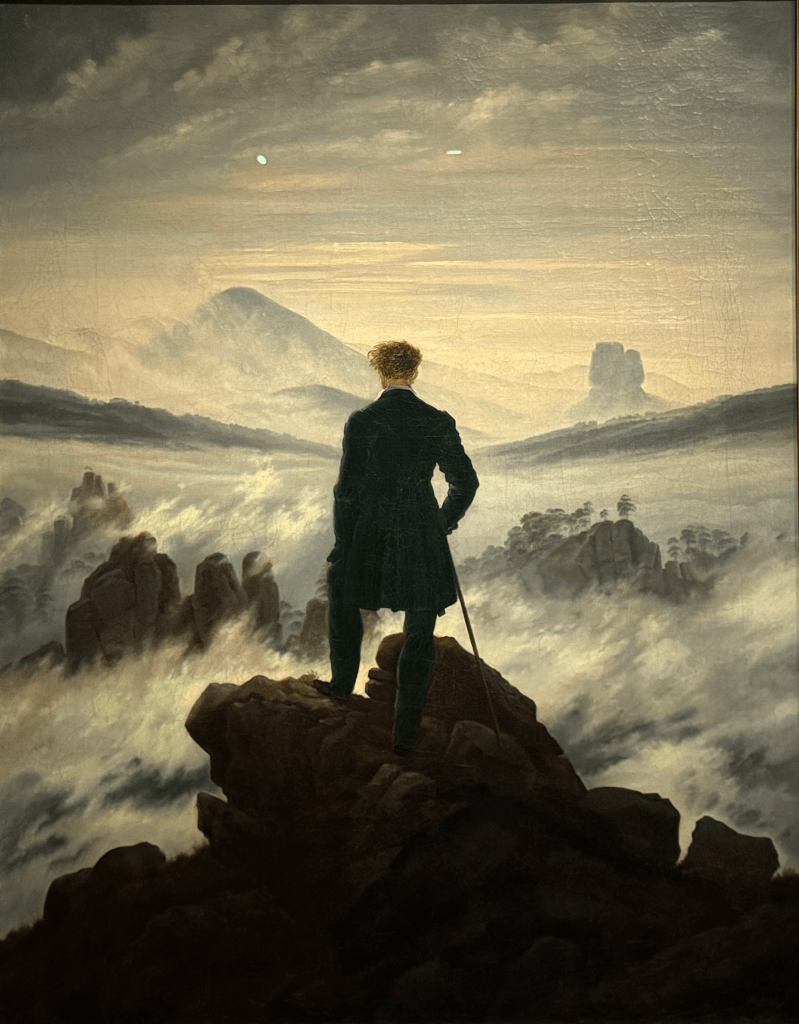
Friedrich advised, “recognize yourselves and your time,” and the equally lucid and evasive Wanderer Above the Sea of Fog reads differently according to one’s period eye. A man at a cliff’s edge could appear desperate any time or place, but his relaxed stance and the rock’s robust contours convey confidence. The German leisure pursuit of hiking, like that of the roaming, urban French flaneur, was “of a privileged class… white artistic and intellectual European men”. Today, some may see this man with his back to us, upon whom clouds converge at the picture’s center, as a conquering hero asserting colonial ambition over the huge expanse – iconography and conventional technique amounting to the “failed Romanticism” of kitsch. Friedrich was not technically experimental like Turner, who influenced Monet and thus avant-garde painting. His native scenes were admired not only by the Hudson River School, whose works arguably expressed the “conquests to come” of Manifest Destiny, but were adapted to Nazi propaganda.
Rightwing sympathizers today may relish Wanderer’s “intolerant ethic of hardness in the face of disorder”. It has illustrated the wandering Zarathustra, and Nietzsche’s “nobly Aryan” Übermensch was similarly co-opted by Nazis. Yet it’s also possible to enjoy this painting as a “defining existentialist image“. Just as Nietzsche’s writing is elliptical and provocative, Friedrich’s figures are ambiguous, speaking to “the void as well as the sublime”. The pyramidal rock juts like the prow of a ship into space as indefinite as it is vast, recalling Nietzsche’s warning: “Whoever fights monsters should see to it that in the process he does not become a monster. And if you gaze long enough into an abyss, the abyss will gaze back into you.” Without question, Wanderer exemplifies Friedrich’s unique contribution to Romanticism: an individual’s ineffable experience of nature.
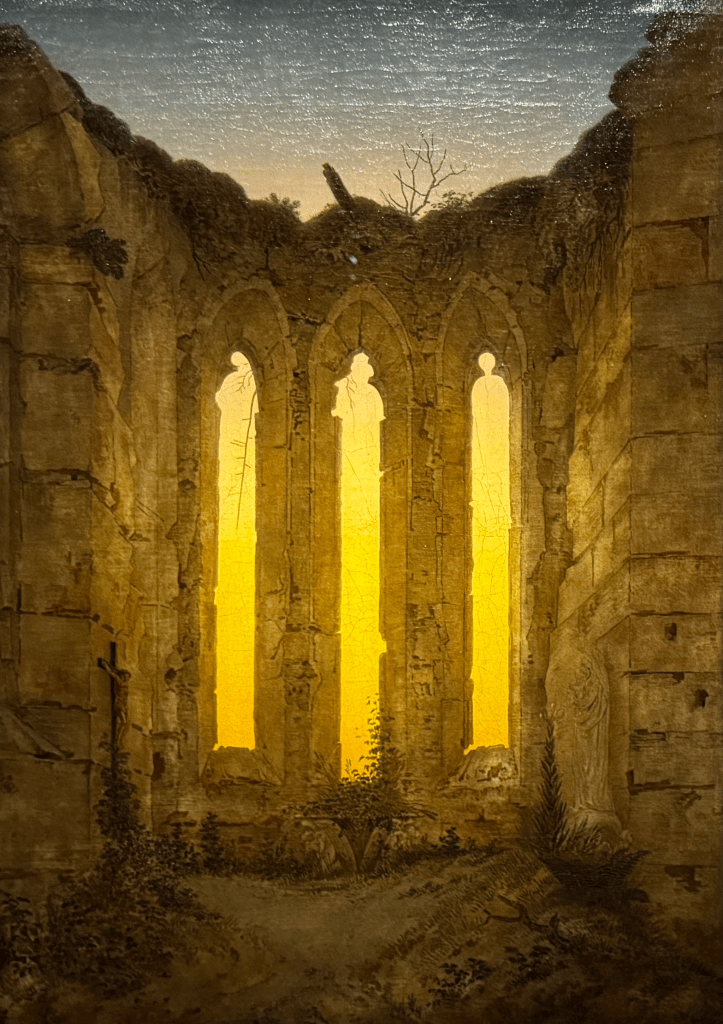
Unlike other northern painters who ventured south to Italy’s precedents and antiquity, Friedrich, like Constable, explored local scenery. His dolmen and ruins evoke the sublimity of epochal time or cataclysm. In Friedrich’s lifetime, Napoleonic wars damaged a landscape already marred by ruins. Two thousand castles were vanquished in the singularly destructive Thirty Years’ War (ending 1648), which killed nearly half the population and led to extremes of witch hunts and the Enlightenment. It was the last of many religious wars sparked by the Reformation (begun 1517), when Catholic buildings were pillaged, closed, or repurposed. Protestant iconoclasm led to fewer commissions for northern painters; when Friedrich procured an altarpiece, he controversially featured landscape, breaking genre convention.
He otherwise earned part of his living from atoning or grieving patrons who bought commemorative Christian pictures. Today these may bring to mind greeting card cliches Friedrich may have helped spawn, too much “a form of vicarious prayer,” or even Thomas Kincade. But Ruins at Oybin avoids cloying piety. One of his many depictions of the site “reconquered by nature,” it exceeds sentimental affiliation with wayside shrines or folly ruins. As in Morning Mist in the Mountains, its icons are submerged, embedded in shadow or ghostly window contours – the larger marvel of natural light reanimating defunct stained glass windows. Sadly, despite Nazi identification with Friedrich’s iconography, “the warnings of hubris in his Gothic ruins were ignored.”
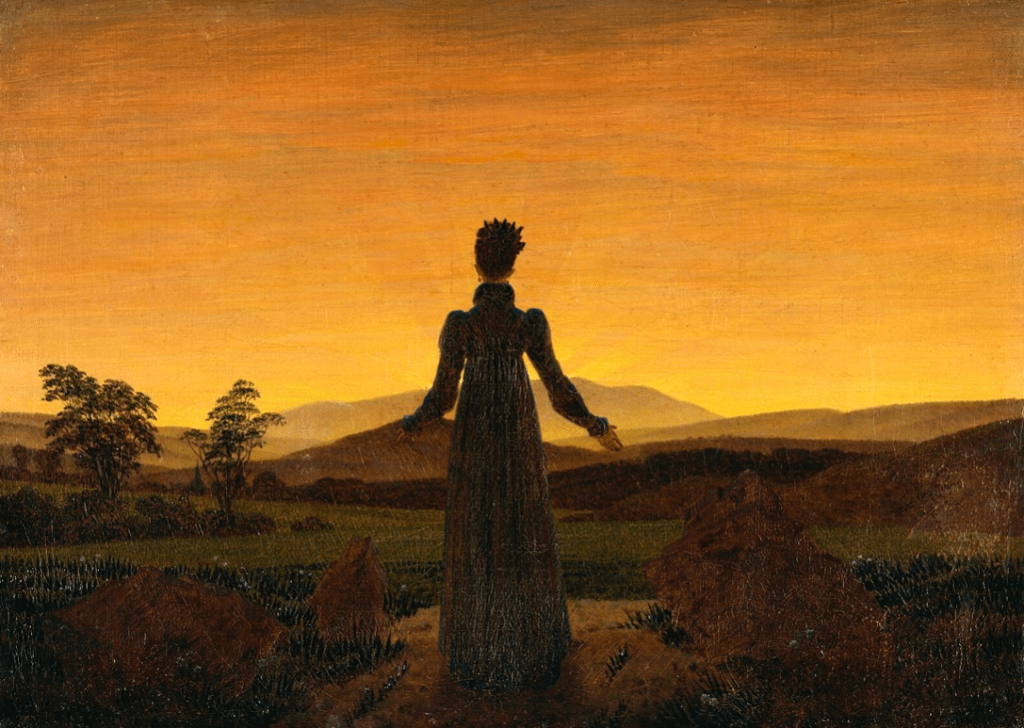
In Woman Before a Rising or Setting Sun, a nearly silhouetted figure stops along a path into an indistinct landscape, arms spread to receive radiant yellow-orange light like an annunciation or stigmatization. Unlike the rear-view figures of Vermeer, Ingres, Hammershoi, Borremans, or Richter, Friedrich’s signature ruckenfiguren straddle anonymity and individual yearning. Caravaggio’s body language employed back views theatrically, leading viewers into scriptural narrative with pantomimed emotion. But Friedrich’s often solitary, taciturn types are in symbiotic rapport with the viewer. Mimicking our position before the painting, they become vehicles, transfixing us with nature’s beauty via his beautiful representation of it. Nebulous meaning invites speculation, recalling Friedrich’s dreamy method: “Sometimes I try to think and nothing comes out of it [so] I doze off and suddenly feel as though someone is rousing me. I am startled, open my eyes, and what my mind was looking for stands before me like an apparition – at once I seize my pencil to draw.” His faceless contemplators would influence the rumination of Bocklin’s Symbolism, de Chirico’s metaphysical painting, and Magritte’s surrealism.
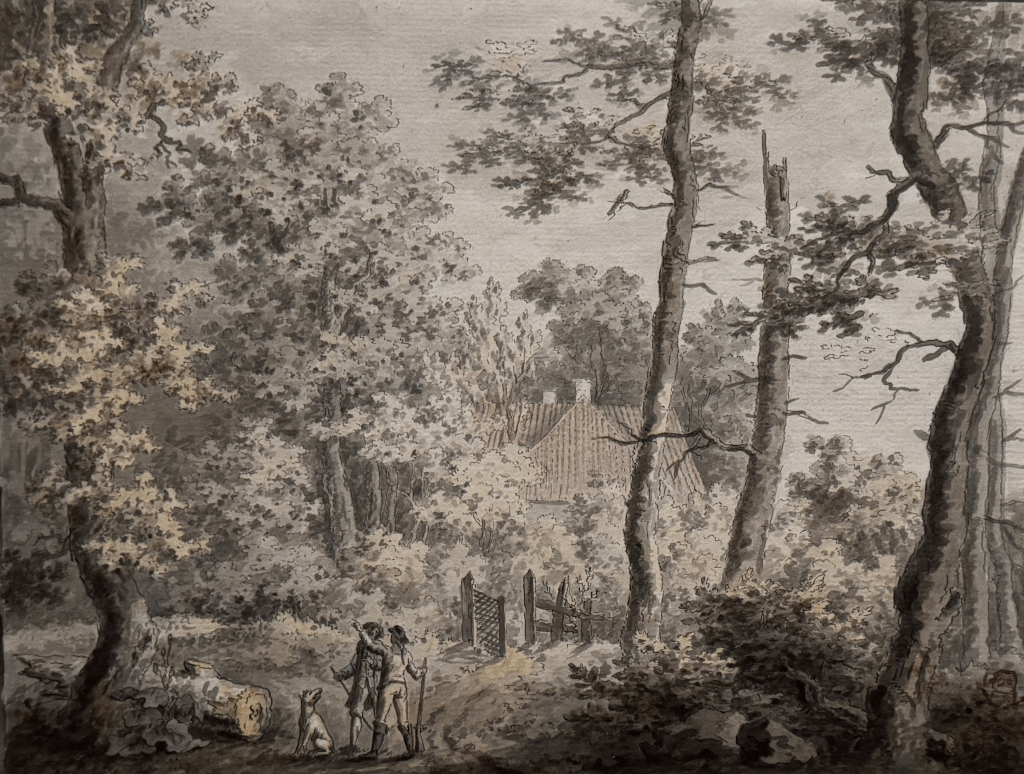
Early on, Friedrich studied drawing intensely with architect Johann G. Quistorp at the University of Griefswald in Swedish Pomerania (now northeastern Germany). His philosophy teacher Thomas Thorild lectured on British aesthetics – the picturesque style’s position between harmonious beauty and the incomprehensible sublime. Country House in a Broadleaf Forest was drawn later, while attending the Royal Danish Academy of Art in Copenhagen across the Baltic Sea, before moving to Dresden (then the “Florence on the Elbe”) to pursue his career and teach. The drawing’s two men and dog look casual and unfettered inside the schematic spatial recession from dark to light, clarity to atmosphere, demonstrating his study of Dutch landscape, which would later influence the en plein air naturalism of Barbizon and Impressionist painters. Size is harder to manipulate in architectural space – Piranesi’s prints notoriously exaggerated Roman monuments – which conforms to human size and perspectival logic. But Altdorfer demonstrated how malleable proportions in landscape are. Likewise, Friedrich’s tiny staffage (neutral figures who create scale), even when foregrounded, render their environment sublimely immense.
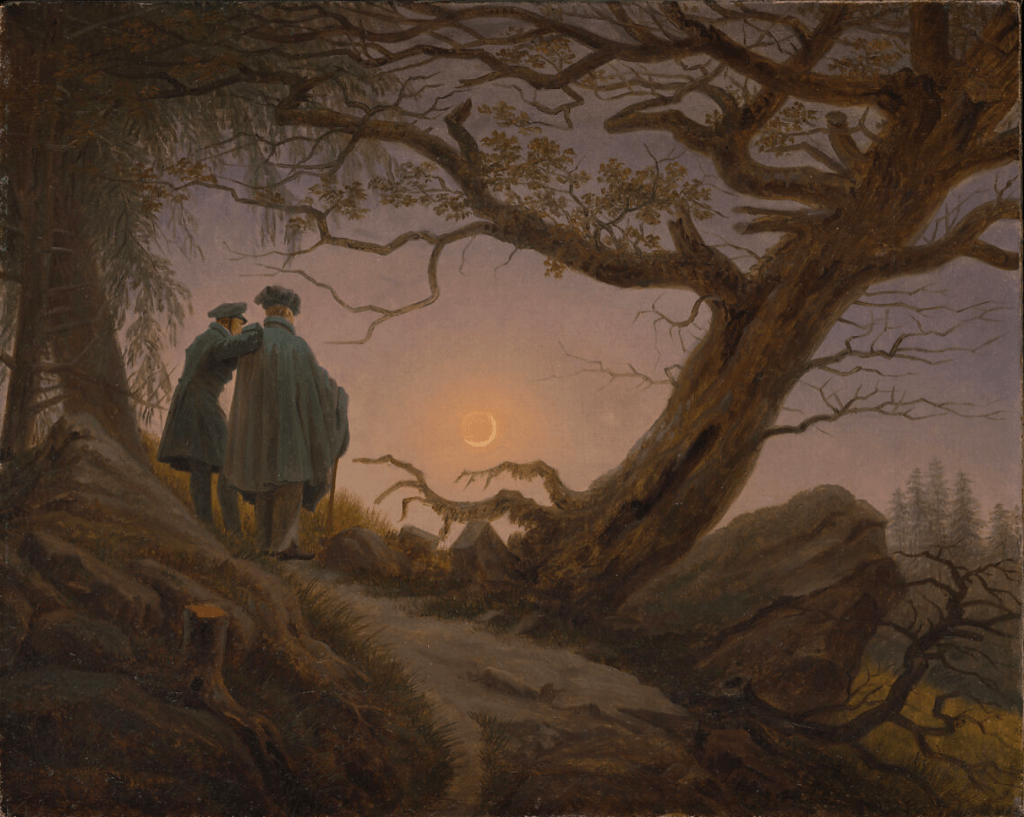
Two Men Contemplating the Moon shows Friedrich’s honed handling of staffage. Its blend of landscape and genre painting shows the influence of his teachers Jens Juel and Christian A. Lorentzen, both inspired by the proto-Romantic Sturm und Drang (“storm and stress”) movement, a mostly literary reaction against Enlightenment reason. But instead of using landscape as a stage for non-heroic human activity as they did, Friedrich makes it the object of his figures’ regard. Two Men’s rich tone, mood, and movement anticipate Albert Pinkham Ryder. We may feel beckoned by the open path into space, but that sense is deterred by the murky foreground, curving, criss-crossing diagonals, and slanting tree’s wildly destabilizing branches. Observing from afar, we gaze up and after them as they look down to ponder the faraway moon. As Peter Schjeldahl wrote, they “intercept our gaze and transmit it into ineffable distance. [Friedrich’s] pictures don’t give; they take.”
This painting inspired Beckett’s “Waiting for Godot,” which drew upon the playwright’s anxious communications during the French Resistance to Nazism. Though Friedrich left town to avoid the 1813 Battle of Dresden, Beckett would have approved (and Hitler disapproved) of Friedrich dressing the pair (fomenting “revolution,” he quipped) in the “Old German costume” sported by politically progressive students.
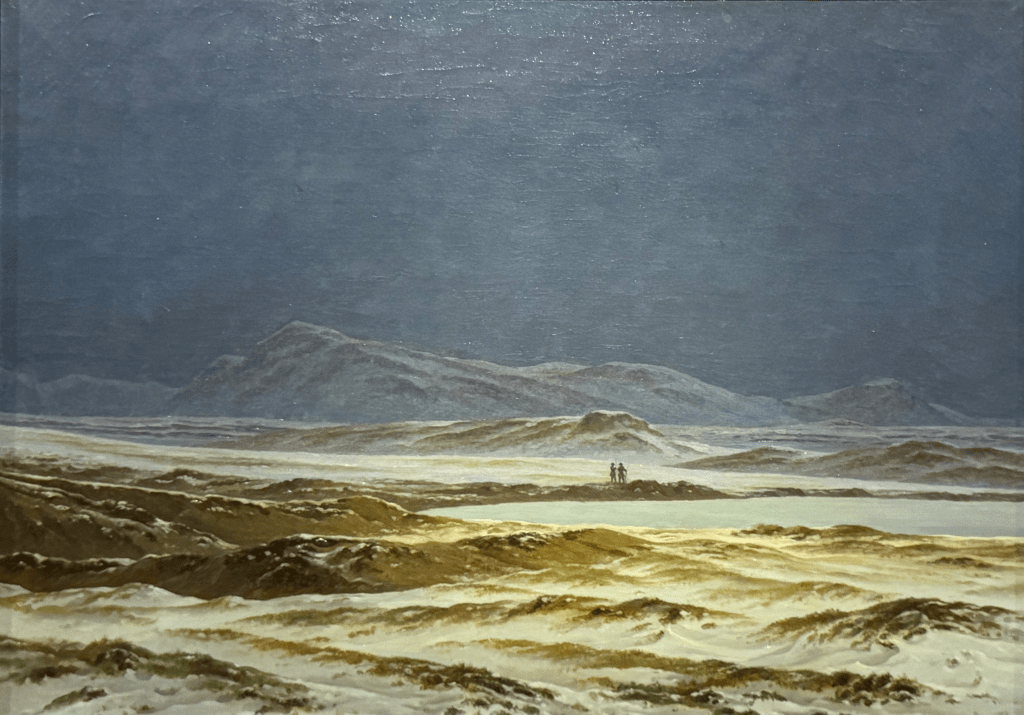
In the bleakly beautiful Northern Landscape, Spring, two minuscule men in the middle of nowhere seem in closer sympathy with Beckett’s bewildered protagonists. Despite warm colors, competing diagonals of rough foreground push us away. An unsympathetic, opaque sky presses in coolly from behind, quietly severe. The distant placement of staffage, as in Van Eyck, Bellini or Brueghel, normally characterizes deep space. But centering undefined protagonists in a harsh hinterland – far less welcoming than that of Rockwell Kent – resonates with the hopeless overtones of two world wars in Alberto Giacometti‘s work. Sublime discomfort shows why Friedrich was dubbed “the man who discovered the tragedy of landscape.”
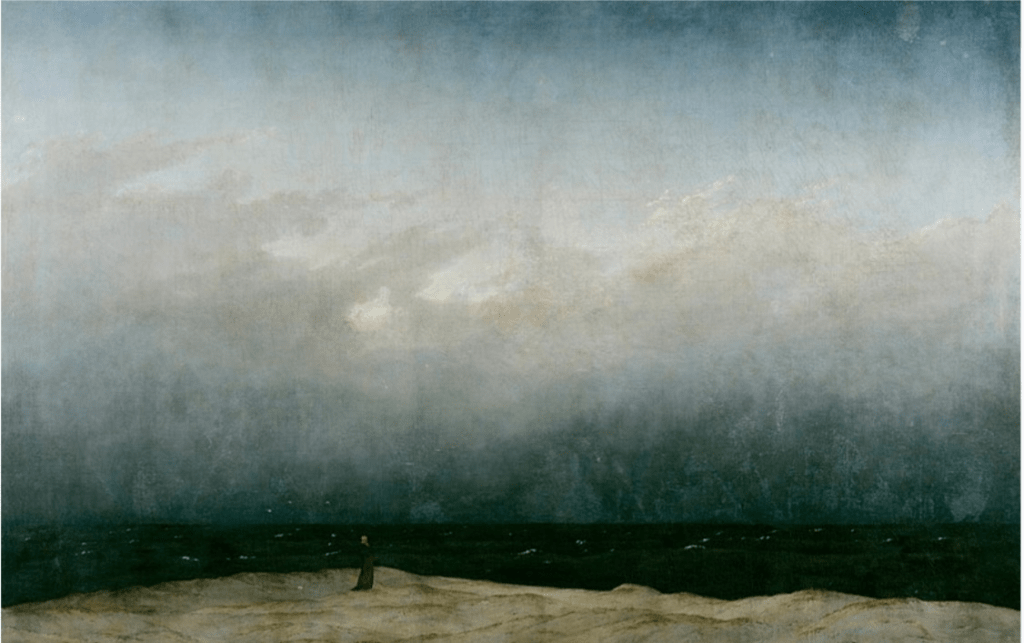
The Monk by the Sea captures the longing Robert Hughes saw as core to Friedrich’s work, so impactful to the enigmas of de Chirico, who studied in Munich. In softly equivocal, horizontal bands of dim color and texture, stark, airy mystery enacts the “boundlessness” Kant ascribed to the sublime in 1790, which Robert Rosunblum traced to Rothko’s spiritual abstract sublime in 1961. A diminutive, barely discernible ruckenfigur is overwhelmed by uncertainty: blank shoreline, blurred horizon, foreboding sea, sfumato mist, frayed clouds, dubious light. This painting was made age 36 during a depressive episode, and while Friedrich’s slow, indirect method was being eclipsed by new interest in spontaneous observation.
The figure could be based on a local preacher who gave sermons on the beach of the isle of Rugen, one of Friedrich’s haunts. His fair hair may also hint at self-portraiture, possibly in sympathy with the younger Nazarenes, German painters who converted to Catholicism in 1809 and moved to Rome to live like monks. Might it also be in solidarity with real painter-monks Filippo Lippi, Fra Angelico, Francisco de Zurbaran, et al? Friedrich painted outside any protective monastery order or walls, in a world both falling apart and slowly taking shape. In 1806, as the vision of a German nation, spurred by Luther’s vernacular Bible, bourgeoned, the dysfunctional Holy Roman Empire of three hundred territories was dissolved. The Napoleonic Code‘s termination of feudalism and serfdom, and the chaos of mediatisation (ownership transfer of ecclesiastical estates to secular authorities) followed. Could this disoriented monk personify fading Catholic identity, and/or Friedrich’s own lost footing on vague and shifting ground?
Friedrich’s later years were hard, and The Monk by the Sea, described as an “existentially deranging prefiguring of Munch’s The Scream,” may foretell his shift from wandering independence – “I must stay alone … to contemplate and feel nature in full… to surrender myself to what encircles me… to merge with my clouds and rocks in order to be what I am” – into illness and alienation. Goethe wrote of its companion piece, Abbey in the Oakwood (not in show), picturing the monk’s burial near a Catholic ruin, “Here is coldness, impetuousness, dying, and despair”. Yet The Monk by the Sea’s openness is also strangely soothing. Heinrich von Kleist‘s 1810 review of it may best describes why, despite Friedrich’s conservative or dour aspects and worst admirers, his work still sustains romantics, introverts, thinkers, and artists: “[T]hat which I should have found within the picture I found instead between the picture and myself, namely, my heart’s aspiration for the picture and my rejection by that picture; and so I myself became the monk”.
“Caspar David Friedrich: The Soul of Nature,” Metropolitan Museum of Art, 1000 Fifth Avenue, New York, NY. Through May 11, 2025.
About the author: Painter and art writer Margaret McCann teaches at the Art Students League. She has shown her work at Antonia Jannone in Milan and been reviewed in La Repubblica, Corriere della Sera, and the Huffington Post. She edited The Figure (Skira/Rizzoli, 2014) for the New York Academy of Art and has written reviews for Painters’ Table and Art New England as well as Two Coats of Paint.





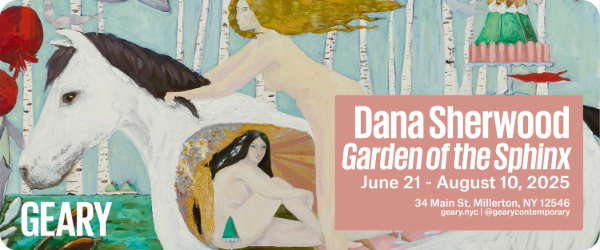










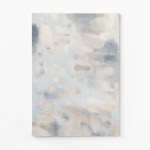



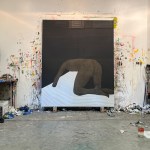

S
Beautiful and very informative article. Isn’t it celebrating his birth, not his death?
Thanks Charlotte for the careful read — it has been corrected.